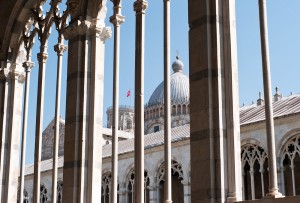I am visiting Andiparos for part of our fall break from the Aegean Center. I have been sleeping in and staying up late reading and watching movies. Today I drove around for a while and photographed some of the stone wall formations that wind their way across the rugged landscape. I am disheartened by some of the building I see going on–large luxury estates high up on the sides of the mountains, along the steeply sloping terrain, ruining the views of the sea. Still, with my Mamiya c330 I can extract the beautiful lines of stone from the uglier new constructions, taking them out of context by cropping out the obvious greed and ego of modern man. Such is my fantasy.
Throughout the day I have had the song “Wichita Lineman”, written by Jimmy Webb and made famous by Glen Campbell, stuck in my head. I have always loved the melodic loneliness and deep heart of this song. A friend, mentor and colleague reminded me recently that country music is just as much ‘soul music’ as the famous hits of Aretha Franklin. This song is a good example for it is in that broad expansive landscape that one hears the lonely soul of America, forever distanced from its European and Asian roots, forever isolated from the rest of the world. Webb wrote,
I am a lineman for the county
and I drive the main road
Searchin’ in the sun for another overload
I hear you singin’ in the wire,
I can hear you through the whine
And the Wichita Lineman
is still on the line
I know I need a small vacation
but it don’t look like rain
And if it snows that stretch down south
won’t ever stand the strain
And I need you more than want you,
and I want you for all time
And the Wichita Lineman is still on the line
Campbell has many religious and political views that I do not share but one enduring legacy that I admire him for, however, has been his musical work, his labor. As a member of the “Wrecking Crew” he was one of the most sought out session players from the 50s through the 60s. He wasn’t a mainstream star until later. Last year he announced publicly that he had been diagnosed with Alzheimer’s Disease. He is currently on tour with his family, a tour which will be his last. When I read Webb’s lyrics again, hearing Campbell’s voice, I cannot help but cry.

County Line Road, between Washington and Marshall Counties, Kansas.
Photo courtesy of Robert Crowe, photographer, St. Louis, Missouri.
For more of Robert Crowe’s photography and prose, please go here.
JDCM





